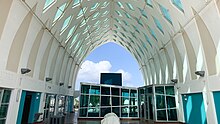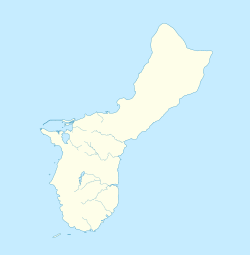 Front of the Guam Museum in 2019 | |
| Established | 1980 |
|---|---|
| Location | 193 Chalan Santo Papa Juan Pablo Dos Hagåtña, GU 96910 |
| Coordinates | 13°28′31″N 144°45′06″E / 13.4752°N 144.7517°E |
| Type | Culture, History, Art |
| Collection size | 250,000 |
| Website | Official website |
The Guam Museum, formally the Senator Antonio M. Palomo Guam Museum & Chamorro Educational Facility, is a museum focusing on the history of Guam, a U.S. territory in Micronesia. A permanent building to house the museum's collection opened in Hagåtña on November 4, 2016.[1] The Guam Museum had been housed in temporary locations since World War II.[2]
History
[edit]Establishment and destruction
[edit]The Guam Museum was founded by the America Legion Mid-Pacific Post 1 in 1932 in Agana, Guam (present-day Hagåtña).[3][4] The American Legion operated the museum from its establishment in 1932 until 1936, when control was transferred to the United States Navy.[3] That same year, Guam Governor George A. Alexander officially established the Guam Museum as a government institution through an executive order.[4][5] The museum's early collection included documents and artifact's from the island's pre-Spanish period.[4]
Guam was invaded by the Japanese in December 1941 and occupied until 1944. The original museum building, along with its entire collection, was destroyed during the 1944 Battle of Guam in which American forces liberated the island from Japanese control.[4]
Temporary locations
[edit]No new museum building was constructed during the post-World War II period.[2][3] On November 24, 1953, Governor Ford Quint Elvidge established the Parks, Monuments, and Museum Committee to re-establish the Guam Museum.[4] The Governor also tasked the Guam Museum with the preservation of Spanish colonial structures and researching the island's history, folklore, and geology.[4] Governor Elvidge appointed Dr. J. Henry Baird as the curator of the Guam Museum and chairman of the Parks, Monuments, and Museum Committee.[4] Still, no structure to house the Guam Museum was built.[2]
Former Senator Tony Palomo, a journalist and historian who specialized in Guam, served as the Director of the Guam Museum from December 1995 until his retirement on June 13, 2007.[6][7][8] Palomo supported the creation of a permanent building for the museum.[2]
An exhibition of Guam's history, operated by the Guam Museum, opened within the Micronesia Mall in April 2004. The exhibit, which was run by the Guam Museum, attracted 200,000 visitors.[7]
Permanent museum proposed (2014)
[edit]
The historic Fort Santa Agueda in Hagåtña was originally proposed as a possible choice for the Guam Museum's new location.[9] However, the Fort, which is listed on the National Register of Historic Places listings in Guam, is preserved by the Guam Historical Preservation Trust, which ruled out the location.[9]
Initial plans for a permanent, modern museum building were first unveiled in 2006.[10]
A groundbreaking ceremony for a new, $27 million permanent home for the Guam Museum was held on February 5, 2013.[2] Construction on the facility, which will house artifacts spanning the island's 4,000 year history, is being funded Hotel Occupancy Tax bond, established by the Public Law 30-228.[2] The museum is on Skinner Plaza in downtown Hagåtña, near the Dulce Nombre de Maria Cathedral Basilica.[2] The new, three-story museum building will include a mezzanine.[2] The museum will also include a cafe, outdoor activity area, theater, bookstore, and atrium.[9]

In a speech at the groundbreaking, Governor Eddie Calvo stated that the Guam Museum would lead to the economic revitalization of Hagåtña, including the Plaza de España, "This will re-energize our capital city to its greatest heights."[2] Calvo also promised that Guamanian historical artifacts housed in the Philippines, Europe and Hawaii will return to Guam to be added to the museum.[2] The Governor also paid tribute to two recently deceased Guamanian historians - the museum's former director, Tony Palomo, who died on February 1, 2013, and Dr. Dirk Ballendorf, the former Director of the Micronesia Area Research Center at the University of Guam, who died on February 4, 2013.[2]
Other dignitaries in attendance at the groundbreaking ceremony included First Lady of Guam Christine Calvo, Speaker Judith Won Pat, Vice Speaker B.J. Cruz, Mayor of Hagåtña John Cruz, Archbishop Anthony Sablan Apuron, and Chairman of the Guam Visitors Bureau Mark Baldyga.[11]
The new museum caused some controversy in Guam.[11] Critics cited the Museum's high cost and location, which will occupy 27 percent of an existing Hagåtña city park, as causes for concern.[9] The museum is also located in a zone with a history of flooding, which could damage the collection.[9] Chairman of Guam Museum Foundation, Monte Mesa, noted that planners had remedied the flooding concerns.[9] The museum is constructed on elevated ground and the institution's most important artifacts will be housed on the three-story building's upper floors, out of reach of potential floodwater.[9]
Permanent museum opened (2016)
[edit]The Guam Museum officially opened on November 4, 2016 under the Guam Department of Chamorro Affairs. Its collection includes more than 250,000 artifacts, documents, and photographs. However, the permanent collection, "I Hinanao-Ta Nu Manaotao Tåno’-I CHamoru Siha: The Journey of the CHamoru People," opened in 2018.[1] The building includes a ground floor exhibition gallery, multipurpose room, and indoor theater. The Museum also hosts the outdoor Movies At The Museum in Skinner Plaza.[12]
References
[edit]- ^ a b Tolentino, Domenica; Murphy, Shannon (February 5, 2019). "Guam Museum". Guampedia. Retrieved 23 March 2021.
- ^ a b c d e f g h i j k Sablan, Jerick (2013-02-06). "Ground broken for a Guam museum". Pacific Daily News. Archived from the original on 2013-04-11. Retrieved 2013-02-14.
- ^ a b c Rogers, Robert F. (1995). "Destiny's Landfall: A History of Guam, page 1952". Destiny's Landfall: A History of Guam. University of Hawaii Press. ISBN 9780824816780. Retrieved 2013-02-19.
- ^ a b c d e f g Baird, J. Henry (1954). "Ground broken for a Guam museum". The Journal of the Polynesian Society Volume 63. Archived from the original on 2011-10-02. Retrieved 2013-02-19.
- ^ Baird, J. Henry (1954). "The Guam Museum". Journal of the Polynesian Society. 63 (3–4). Auckland, New Zealand: Polynesian Society: 253–254. Archived from the original on 2 October 2011. Retrieved 11 May 2011.
- ^ Sablan, Jerick (2013-02-02). "Former senator Palomo dies at 81". Pacific Daily News. Archived from the original on 2013-04-11. Retrieved 2013-02-14.
- ^ a b "Tony Palomo, Advisor and author". Guampedia. Retrieved 2013-02-14.
- ^ Bordallo, Madeleine (2007-07-20). "Recognizing Antonio Manibusan Palomo = Speech of Hon. Madeleine Bordallo of Guam in the House of Representatives". Rep. Madeleine Bordallo. Library of Congress Congressional Record 110th Congress (2007-2008). Archived from the original on 2017-08-09. Retrieved 2013-02-19.
- ^ a b c d e f g White, Joy (2013-02-06). "Guam museum breaks ground, concerns resolved". Marianas Variety. Retrieved 2013-02-19.
- ^ Taitano DeLisle, Christine (2010). "Civilizing the Guam Museum" (PDF). University of Michigan Working Papers in Museum Studies Number 4. Retrieved 2013-02-19.
- ^ a b Toves, Jolene (2013-02-05). "Groundbreaking held for new Guam Museum". KUAM. Retrieved 2013-02-19.
- ^ "The History of the Guam Museum". Guam Museum. 16 July 2015. Retrieved 23 March 2021.
